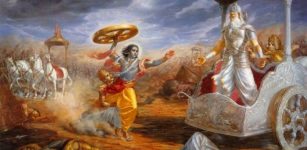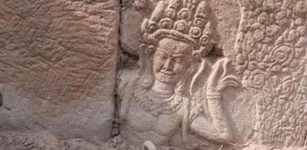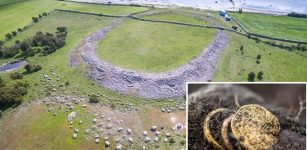Why Are Medieval Manuscripts Full Of Doodles Of Snail Fights?
AncientPages.com - The doodles found in the margins of very old manuscripts are often just as interesting as the content of the manuscripts themselves. One such example is the frequently recurring – and extremely odd – image of knights warring against snails.
From the late 13th century through to the 15th century, images of knights fighting snails pop up in all sorts of unlikely places within the medieval literary world. And they reveal fascinating insights into what medieval people thought about the world around them.
Battle in the margins from the Gorleston Psalter (1310-1324). British Library
Images of knights fighting snails first started to emerge in North French illuminated manuscripts (which are decorated with richly coloured illustrations) towards the end of the 13th century (around 1290). A few years on – although slightly less consistently – these same images started appearing in Flemish and English manuscripts.
Interestingly, in most cases these snail doodles appear to be unrelated to the adjoining illustrations of textual passages.
Often, the doodles depicted an armed knight confronting a snail whose horns were extended and pointing like arrows. In the manuscripts of the French folktale, Le Roman de Renart, the weapons that the knights were depicted with varied between sticks, maces, flails, axes, swords and even forks.
Snail assailants are almost always male knights. However, there is one known instance of a woman opposing a snail wielding a spear and shield.
As these snail combat doodles increased in popularity within manuscripts, they became an accepted element of medieval imagery. From here, they spread to other areas of medieval life.
Decorative panels carved around 1310 on the main entrance of Lyon Cathedral in France, for example, showcase a knight confronting a snail and another man threatening a dog-headed giant snail with an axe.
Despite travelling across the continent, the knights versus snails motif varied little from country to country, which suggests that it may have had a deeper meaning.
Medieval satire
Nobody knows exactly why battles between snails and knights were so popular throughout the middle ages. One theory is that these doodles added humour to texts which were otherwise quite dry and serious.
A reader could rest their eyes by taking a moment to laugh at the scene of snail combat before continuing with their reading.
Extreme jousting from Brunetto Latini’s Li Livres dou Tresor, (c. 1315-1325). Courtesy of the British Library
Many of the doodles show a knight dropping their sword or kneeling submissively before their diminutive shelled foe, which accentuates its satirical implications. There are also several representations of women pleading with knights not to attack the formidable beasts.
Other similarly lighthearted imagery includes a cat stalking a snail with the head of a mouse, as well as dogs, monkeys, dragons and even rabbits in fierce opposition with the molluscs.
The meaning of the snail motif
Snails were recognised in medieval times for their unusual strength, given that they were able to carry their home on their back. Confrontation with a snail, therefore, could represent a test of personal strength as well as mental fortitude.
Once a symbol of deceptive courage, the snail became a creature to be hunted down and destroyed in a display of strength and bravery.
A disarmed monk faces a snail opponent, from The Book of Hours (c. 1320-1330). Courtesy of the British Library
Like many other subjects popularised in marginal illuminations of the 1300s, the snail and knight duo gradually disappeared as time wore on. They experienced a brief revival, however, in medieval manuscripts towards the end of the 15th century.
The gastropod conqueror from the Gorleston Psalter, 1310-1324. Courtesy of the British Library
A knight versus snail fight from the Smithfield Decretals ( c.1300-1340). Courtesy of the British Library
And they haven’t completely disappeared from the common imagination. Today the pairing can still be enjoyed in the nursery rhyme, Four-and-Twenty Tailors Went To Kill a Snail:
Four-and-twenty tailors went to kill a snail,
The best man amongst them durst not touch her tail;
She put out her horns like a little Kyloe cow;
Run, tailors, run, or she’ll kill you all e’en now.
Written by Madeleine S. Killacky, PhD Candidate, Medieval Literature, Bangor University
Provided by The Conversation
This article is republished from The Conversation under a Creative Commons license. Read the original article.
More From Ancient Pages
-
 Dazzling Time Capsule Of Unique Iron Age Artifacts And Celtic Roundhouses Discovered In England
Archaeology | Mar 15, 2022
Dazzling Time Capsule Of Unique Iron Age Artifacts And Celtic Roundhouses Discovered In England
Archaeology | Mar 15, 2022 -
 Unusual Tukuturi Statue On Easter Island Remains An Unexplained Mystery
Civilizations | Jan 16, 2019
Unusual Tukuturi Statue On Easter Island Remains An Unexplained Mystery
Civilizations | Jan 16, 2019 -
 19 Cannons Shot From British Ships During The American Revolution Discovered In Savannah River
Archaeology | Apr 29, 2022
19 Cannons Shot From British Ships During The American Revolution Discovered In Savannah River
Archaeology | Apr 29, 2022 -
 The Maya Produced Rubber 3,000 Years Before Goodyear
Ancient History Facts | Mar 12, 2016
The Maya Produced Rubber 3,000 Years Before Goodyear
Ancient History Facts | Mar 12, 2016 -
 Climate, Conflict, Collapse: How Drought Destabilized The Last Major Precolonial Mayan City
Featured Stories | Jul 25, 2022
Climate, Conflict, Collapse: How Drought Destabilized The Last Major Precolonial Mayan City
Featured Stories | Jul 25, 2022 -
 God Patecatl – Father Of ‘Four Hundred Rabbits’ In Aztec Beliefs
Aztec Mythology | Mar 9, 2018
God Patecatl – Father Of ‘Four Hundred Rabbits’ In Aztec Beliefs
Aztec Mythology | Mar 9, 2018 -
 Mysterious Maya Snake Kings And Their Powerful Kingdom In The Jungle Reveal More Ancient Secrets
Civilizations | Apr 23, 2018
Mysterious Maya Snake Kings And Their Powerful Kingdom In The Jungle Reveal More Ancient Secrets
Civilizations | Apr 23, 2018 -
 Call Modern Humans Homo Faber, The Toolmaker – Not Homo Sapiens – Scientist Says
Archaeology | May 16, 2022
Call Modern Humans Homo Faber, The Toolmaker – Not Homo Sapiens – Scientist Says
Archaeology | May 16, 2022 -
 Scientists Unravel The Mystery Of The Alexander Sawney Bean Legend & Cave-Dwelling Cannibals In Scotland
Myths & Legends | Sep 24, 2015
Scientists Unravel The Mystery Of The Alexander Sawney Bean Legend & Cave-Dwelling Cannibals In Scotland
Myths & Legends | Sep 24, 2015 -
 On This Day In History: Samuel Morey Patents The Internal Combustion Engine – On April 1, 1826
News | Apr 1, 2017
On This Day In History: Samuel Morey Patents The Internal Combustion Engine – On April 1, 1826
News | Apr 1, 2017 -
 Reconstructing The Lost Ancient World Of The Marquesas Islands With Unique Plants And Animals
News | Mar 31, 2022
Reconstructing The Lost Ancient World Of The Marquesas Islands With Unique Plants And Animals
News | Mar 31, 2022 -
 Cyclops – First Generation Of Giants Who Were Prisoners Of Tartarus
Featured Stories | Mar 21, 2018
Cyclops – First Generation Of Giants Who Were Prisoners Of Tartarus
Featured Stories | Mar 21, 2018 -
 Beautiful Mosaics In 1,300-Year-Old Church Discovered In The Lower Galilee
Archaeology | Aug 29, 2020
Beautiful Mosaics In 1,300-Year-Old Church Discovered In The Lower Galilee
Archaeology | Aug 29, 2020 -
 The Man Who Took The Greatest Alchemy Secret Of All Time To His Grave
Ancient Mysteries | Jul 16, 2020
The Man Who Took The Greatest Alchemy Secret Of All Time To His Grave
Ancient Mysteries | Jul 16, 2020 -
 2,500-Year-Old Olmec Related Mexican Cave Paintings Are Now Restored And Protected
Civilizations | Sep 18, 2015
2,500-Year-Old Olmec Related Mexican Cave Paintings Are Now Restored And Protected
Civilizations | Sep 18, 2015 -
 Illuminated Ancient Manuscripts Reflect 1,000 Years Of Human History
Artifacts | Sep 12, 2015
Illuminated Ancient Manuscripts Reflect 1,000 Years Of Human History
Artifacts | Sep 12, 2015 -
 DNA Study Suggests Human Language Emerged 135,000 Years Ago
DNA | Mar 14, 2025
DNA Study Suggests Human Language Emerged 135,000 Years Ago
DNA | Mar 14, 2025 -
 Mahabharata Is Much Older Than Previously Thought – Archaeological Discovery Reveals
Archaeology | Oct 22, 2019
Mahabharata Is Much Older Than Previously Thought – Archaeological Discovery Reveals
Archaeology | Oct 22, 2019 -
 Apsara Carvings Dated To 12th Century Uncovered At Takav Gate In Angkor, Cambodia
Archaeology | May 5, 2022
Apsara Carvings Dated To 12th Century Uncovered At Takav Gate In Angkor, Cambodia
Archaeology | May 5, 2022 -
 Gold Coins Shed Light On The Mystery Of Sandby Borg And Massacre On The Swedish Island
Archaeology | Oct 16, 2017
Gold Coins Shed Light On The Mystery Of Sandby Borg And Massacre On The Swedish Island
Archaeology | Oct 16, 2017





